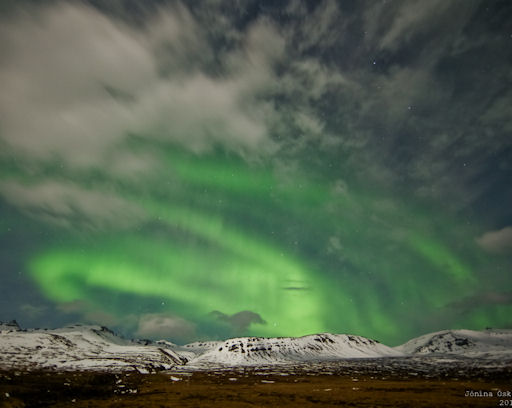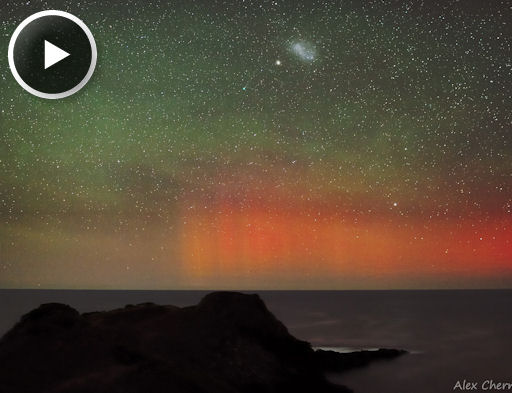Hang the Transit of Venus on your wall! Hubble-quality images from NASA's Solar Dynamics Observatory are now available as metallic posters in the Space Weather Store. | | |
DECREASING CHANCE OF FLARES: Sunspot AR1678 is turning away from Earth, sharply decreasing the odds of a geoeffective eruption. Nevertheless, the sunspot still has a delta-class magnetic field that harbors energy for significant flares. NOAA forecasters estimate a 40% chance of M-class solar flares and a 10% chance of X-flares during the next 24 hours. Solar flare alerts: text, voice.
LAST NIGHT IN ICELAND: No solar activity, no problem. The gentle buffeting of the solar wind continues to be enough to spark auroras around the Arctic Circle. Here was the scene last night in Iceland:

"Bright moonlight lit up the night like midday," says photographer Jónína Óskarsdóttir of Faskrudsfjordur, Iceland. "Nevertheless, the auroras were plainly visible."
The waxing Moon will brighten furthern tonight. Will the Northern Lights continue to penetrate the glare? Stay tuned: NOAA forecasters estimate a 25% chance of polar geomagnetic storms on Feb. 22-23. Aurora alerts: text, voice.
Realtime Aurora Photo Gallery
TWO COMETS AND THE SOUTHERN LIGHTS: Two comets are now visible in the skies of the southern hemisphere: "Comet Lemmon and Comet PanSTARRS got close enough together on the morning of Feb. 17th to fit into single image with a 35mm lens," reports Alex Cherney of Flinders, Victoria, Australia. "A brief but reasonably strong aurora was a welcome bonus." Click to set the scene in motion:

"Both comets were faint but visible to the naked eye, C/2011 L4 (PanSTARRS) slightly brighter than C/2012 F6 (Lemmon)," says Cherney. "I would guestimate the visual magnitude of Comet Lemmon at +5.5 and PanSTARRS at +5." Also visible in Cherney's images are the Small Magellanic Cloud and the 47 Tuc globular star cluster.
Comet Pan-STARRS is heading for a close encounter with the sun just inside the orbit of Mercury that could significantly boost its visibility in early March. At that time, the comet will be visible to northern-hemisphere observers as well. A video from NASA explores the possibilities.
More about Comet Lemmon: 3D orbit, ephemeris, light curves; and Comet Pan-STARRS: 3D orbit, ephemeris, light curves.
Realtime Comet Photo Gallery
Realtime Space Weather Photo Gallery
Realtime Noctilucent Cloud Photo Gallery
[previous years: 2003, 2004, 2005, 2006, 2007, 2008, 2009, 2011]

